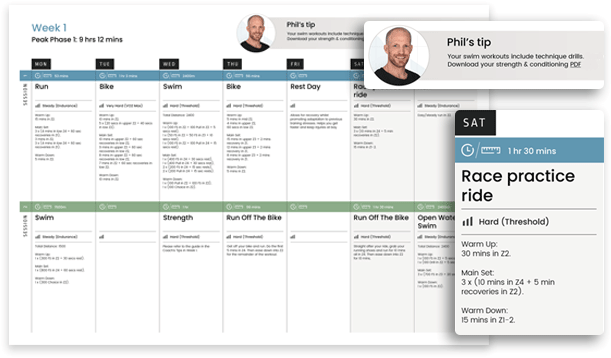Free Ultra Marathon Training Plans & Tips
- Detailed 9- and 12-week training plans
- Beginner, Intermediate & Advanced versions
*Plus, you’ll also receive free regular training tips from head coach Phil Mosley! Unsubscribe at any time.
How To Train For An Ultra Marathon
- Scroll down for our 12-week training plan in full!
An ultra-marathon is any running event that’s longer than a standard marathon (26.2 miles). There is no single set distance, but ultra-marathon events commonly go up to 100km (62 miles). There are also multi-day Ultra events.
Like all runs, ultra-marathons vary in terms of terrain and elevation. You get some that are flat, some that are undulating, and some that are mountainous and technical.
If you’re training for an Ultra that includes lots of technical trails AND big climbs, you need to approach your training differently than you would for a less-extreme route.
For this reason, we designed a range of Ultra Marathon AND Hilly Ultra Trail Marathon training plans – to make sure you’re fully prepared, no matter what.
Running Tips
Training for an ultra-marathon is no different to training for other running events, in that you need to progress your training gradually over time. There are no shortcuts. You also need to include regular recovery periods, so that your body can adapt, enabling you to train consistently for many months.
Your training should be built around three key runs each week. The first is a long run, where you slowly increase the duration over a period of months, up to a maximum of 5 hours (depending on the distance of your target event). This run should be done at chatting pace, ideally over a series of laps, so you can take on energy drinks and snacks at the end of each lap.
If you are training for a hilly ultra choose terrain and elevation proportionally similar to that of your chosen race. Training for long durations on trails in the hills/mountains will take some preparation and forethought. Your backpack may need to contain spare kit, nutrition, hydration, phone, navigation, mini first aid, cash, sun protection and more.
Your second key run is also relatively long, typically done in midweek, where you build up over several months to running a maximum of 2 hours. This run should ideally be done on terrain or gradients that are like your target event.
For your long runs, it’s always good to run in company, at least for some of it. It’s great motivation and it helps the miles fly by. Do your best to work this into your training plan if you can. Otherwise, it can get tough at times.
The final key run is a speed or tempo session. These are not endurance sessions as such, but they do improve your running pace, which then enables you to run at a given pace for less effort. You can vary these types of workouts throughout the course of your training. For example, you could try a weekly tempo session such as 5 x 1 mile at 10-mile race pace, with 1-minute recoveries (plus a warm up and cool down). After four weeks of that, you could progress it to 3 x 2 miles with 90 seconds recoveries.
Once you’ve done eight weeks of weekly tempo runs, move onto some speed work for the next eight weeks. For example, try doing 5 x 800m hard with 2 minutes 30-second recoveries (plus warm up and cool down). Progress your workouts every four weeks to keep your training fresh, and to encourage your body to keep adapting.
For Hilly Ultra Trail races these key runs will include skill-specific sessions. Such as training to improve your strength and efficiency in preparation for the ascents and descents you will encounter. Include workouts that have intervals of effort for both up and downhill running.
Any other runs can be done at chatting pace, typically 35 to 75 minutes in duration. If possible, do some of your running on soft surfaces like grass or trails, to reduce the impact on your body. Always be mindful of avoiding injury – over half of all runners are injured every year. Your first goal is always to make the start-line of your target race.
For this reason, we alternate the duration of the long runs in our training plans, so you’re not hammering your body every single weekend. Our training plans feature a three-week cycle like this:
Week 1: Moderately Long Sunday Run, Week 2: Long Sunday Run, Week 3: Active Recovery Week.
During your “active recovery weeks” your training is half as much as normal. This gives your body a chance to adapt, boosting your fitness and reducing your chances of getting injured.
After each “active recovery week” we then gradually progress the difficulty of your key workouts, so you’re continually challenged. This pattern of training will ensure you improve at the optimal rate.
Strength Training Tips
In our ultra-marathon training plans, there are usually two 40-minute strength and conditioning sessions per week. These workouts can help improve your strength and flexibility, leading to more efficient movement patterns and fewer injuries. We suggest you only do strength work in addition to at least three runs per week, rather than instead of them. However, strength work is an important ingredient when preparing for an ultra-marathon.
Using An Ultra Marathon Training Plan
Our training plans are for athletes who don’t feel the need for a personal coach, but who still want the structure and planning of an expertly-written training program. People who use training plans have been shown to be twice as likely to succeed in reaching their goals.
If you’re planning to do an Ultra Marathon, it helps if you’re already a runner, and you’ve already conquered some running events over shorter distances, such as a half marathon or marathon. If you’re starting from scratch, it’s a good idea to train for some shorter events first, before taking on the challenge of an Ultra.
Getting fit for Ultra Marathon will take longer than 8 or 12 weeks, especially if you’re relatively new to long-distance running. The free training plans on this page give you an idea of what to expect, but you may also benefit from a longer plan that starts off easier and ramps-up more gradually. Click here to browse our 9 to 39-week Ultra and Hilly Ultra Trail Marathon training plans (with email support).
Do your best to follow the workouts below, ideally in their given order. To help you train at the right levels, we use five training zones, based on feel or heart rate. If you use heart rate, you can use our simple heart rate training zone calculator. Note: our premium plans include fitness tests for smarter, personalised training zones on every workout.
- Zone 1 – Feels like “Easy/Recovery” – Heart rate 68-73% of max.
- Zone 2 – Feels like “Steady/Endurance” – Heart rate 73-80% of max.
- Zone 3 – Feels like “Mod. Hard/Tempo” – Heart rate 80-87% of max.
- Zone 4 – Feels like “Hard/Threshold” – Heart rate 87-93% of max.
- Zone 5 – Feels like “V. Hard/VO2 Max” – Heart rate 93-100% of max.
We abbreviate your zones to keep things easy to read:
- Z1 to Z5 – Your training zone.
- Detailed 9- and 12-week training plans
- Beginner, Intermediate & Advanced versions
- Strength & Conditioning guide, coach's tips and more!
*Plus, you’ll also receive free regular training tips from head coach Phil Mosley! Unsubscribe at any time.
12-Week Beginner Ultra Marathon Plan
This plan is suitable for Beginner or time-limited runners, aiming to get in peak shape for an Ultra Marathon event. With just 12 weeks to go until event-day, this plan assumes you are currently able to run/jog/walk for 3 hrs 30 mins. A good way to avoid injury and stay motivated is by following an expertly designed training plan. People who follow a training plan have been shown to be twice as likely to succeed in reaching their goal.
Average weekly training hours are 5:02 with the biggest week at 8:24 hours. There are four runs and a 45-minute strength and conditioning session. There is usually one workout per day and one day off each week. Your plan features a three-week cycle like this:
- Week 1: Moderately Long Sunday Run
- Week 2: Long Sunday Run
- Week 3: Active Recovery Week.
- To get the 9-week version of this plan and access to the Strength & Conditioning guide, please enter your email above.
Week 1 - Build Phase 1 (5 hrs 50 mins)
Monday: Recovery Day
- Allows for recovery whilst promoting adaptation to previous training stresses. Helps you get faster and keep injuries at bay.
Tuesday: Aerobic Endurance – Steady/Endurance (50 mins)
- All in low to mid Z2.
Wednesday: Aerobic Endurance – Steady/Endurance (1 hr)
- All in low to mid Z2. These runs are to be done slowly. They will gradually build your endurance and increase your efficiency. If you do them faster, you’ll increase your injury risk for no real benefit. If you need to include some walking sections in these runs, in order to keep your heart rate down, that’s fine.
Thursday: Strength – Adaptation Phase (45 mins)
Friday: Progression Run – Hard/Threshold (45 mins)
- Main Set:
- 5 mins in low Z2,
- 5 mins in mid Z2,
- 5 mins in upper Z2,
- 5 mins in low Z3,
- 5 mins in mid Z3,
- 5 mins in upper Z3,
- 5 mins in low Z4,
- 5 mins in mid Z4.
- Warm Down:
- 5 mins in low Z2.
This tough workout will improve your running stamina and teach the body and mind to stay strong throughout your race.
Saturday: Recovery Day
Sunday: Aerobic Endurance – Steady/Endurance (2 hrs 30 mins)
- Easy or steady run all in low to mid Z2. This is your long run and will gradually increase in duration. If you need to include some walking sections in these runs, in order to keep your heart rate down, that’s fine.
- Your plan features a three-week cycle like this:
- Week 1: Moderately Long Sunday Run
- Week 2: Long Sunday Run
- Week 3: Active Recovery Week.
- Click the headings below to view the remaining weeks!
Week 2 - Build Phase 1 (6 hrs 30 mins)
Monday: Recovery Day
Tuesday: Aerobic Endurance – Steady/Endurance (30 mins)
- All in low to mid Z2.
Wednesday: Aerobic Endurance/Strength – Steady/Endurance (1 hr)
- All in upper Z1 to low Z2. Ideally on a hilly route.
Thursday: Strength – Adaptation Phase (45 mins)
Friday: Progression Run – Hard/Threshold (45 mins)
- Main Set:
- 5 mins in low Z2,
- 5 mins in mid Z2,
- 5 mins in upper Z2,
- 5 mins in low Z3,
- 5 mins in mid Z3,
- 5 mins in upper Z3,
- 5 mins in low Z4,
- 5 mins in mid Z4.
- Warm Down:
- 5 mins in low Z2
Saturday: Recovery Day
Sunday: Aerobic Endurance – Easy/Endurance (3 hrs 30 mins)
- Run/jog/walk all in Z1 to low Z2. It is key for you to gradually progress your running volume. Always be mindful of avoiding injury – over half of all runners are injured every year. Your first goal is always to make the start-line of your target race. With this in mind, if the long runs in this plan are more than 15% longer than you have done before then scale them back to no more than 10-15% longer than your last recent long run.
Week 3 - Active Recovery Week (3 hrs 32 mins)
Monday: Recovery Day
- It’s vital to make the most of these recovery weeks, as this training plan will get tougher and tougher as it goes on. You need to fully recover and start each new training phase feeling fresh and eager to train hard. There is enough training during the recovery weeks so that you won’t lose fitness
Tuesday: Recovery Day
- All in low to mid Z2.
Wednesday: Tempo Run – Hard/Threshold (32 mins)
- Warm Up:
- 15 mins in Z2 to Z3.
- Main Set:
- 12 mins in low Z4.
- Warm Down:
- 5 mins in Z2.
Thursday: Strength – Endurance Phase (45 mins)
Friday: Aerobic Endurance – Steady/Endurance (45 mins)
- All in Z2.
Saturday: Aerobic Endurance – Steady/Endurance (30 mins)
- All in low to mid Z2.
Sunday: Aerobic Endurance – Steady/Endurance (1 hr)
- Easy or steady run all in low to mid Z2.
Week 4 - Build Phase 2 (6 hrs 15 mins)
Monday: Recovery Day
Tuesday: Aerobic Endurance – Steady/Endurance (1 hr)
- All in low to mid Z2.
Wednesday: Aerobic Endurance/ Strength – Steady/Endurance (1 hr 10 mins)
- All in upper Z1 to low Z2. Ideally on a hilly route.
Thursday: Strength – Endurance Phase (45 mins)
Friday: Progression Run – Hard/Threshold (50 mins)
- Main Set:
- 10 mins in low Z2,
- 5 mins in upper Z2,
- 10 mins in low Z3,
- 10 mins in upper Z3,
- 5 mins in low Z4,
- 5 mins in mid Z4.
- Warm Down:
- 5 mins in low Z2.
Saturday: Recovery Day
Sunday: Aerobic Endurance – Steady/Endurance (2 hrs 30 mins)
- Run/jog/walk all in upper Z1 to low Z2.
Week 5 - Build Phase 2 (7 hrs 20 mins)
Monday: Recovery Day
Tuesday: Aerobic Endurance – Steady/Endurance (30 mins)
- All in low to mid Z2.
Wednesday: Aerobic Endurance/Strength – Steady/Endurance (1 hr 10 mins)
- All in upper Z1 to low Z2. Ideally on a hilly route.
Thursday: Strength – Endurance Phase (45 mins)
Friday: Progression Run – Hard/Threshold (55 mins)
- Main Set:
- 10 mins in low Z2,
- 10 mins in upper Z2,
- 10 mins in low Z3,
- 10 mins in upper Z3,
- 5 mins in low Z4,
- 5 mins in mid Z4.
- Warm Down:
- 5 mins in low Z2.
Saturday: Recovery Day
Sunday: Aerobic Endurance – Steady/Endurance (4 hrs)
- Run/jog/walk all in Z1 to low Z2.
Week 6 - Active Recovery Week (3 hrs 44 mins)
Monday: Recovery Day
Tuesday: Recovery Day
Wednesday: Tempo Run – Hard/Threshold (34 mins)
- Warm Up:
- 15 mins in Z2 to Z3.
- Main Set:
- 2 x (7 mins in low Z4 + 2 mins recovery in Z1).
- Warm Down:
- 5 mins in Z2.
Thursday: Strength – Endurance Phase (45 mins)
Friday: Aerobic Endurance – Steady/Endurance (45 mins)
- All in Z2.
Saturday: Aerobic Endurance – Steady/Endurance (30 mins)
- All in low to mid Z2.
Sunday: Aerobic Endurance – Steady/Endurance (1 hr 10 mins)
- Easy or steady run all in Z2.
Week 7 - Peak Phase 1 (6 hrs 54 mins)
Monday: Recovery Day
Tuesday: Aerobic Endurance – Steady/Endurance (50 mins)
- All in low to mid Z2.
Wednesday: Aerobic Endurance/ Strength – Steady/Endurance (1 hr 30 mins)
- All in upper Z1 to low Z2. Ideally on a hilly route.
Thursday: Strength – Endurance Phase (45 mins)
Friday: Tempo Run – Hard/Threshold (49 mins)
- Warm Up:
- 15 mins in Z2 to Z3.
- Main Set:
- 4 x (5 mins in Z4 + 1 min recoveries in Z1),
- Warm Down:
- 10 mins in Z2.
Saturday: Recovery Day
Sunday: Aerobic Endurance – Easy/Endurance (3 hrs)
- Run/jog/walk all in upper Z1 to low Z2.
Week 8 - Peak Phase 1 (7 hrs 59 mins)
Monday: Recovery Day
Tuesday: Aerobic Endurance/ Strength – Steady/Endurance (30 mins)
- All in low to mid Z2.
Wednesday: Aerobic Endurance/ Strength – Steady/Endurance (1 hr 30 mins)
- All in upper Z1 to low Z2. Ideally on a hilly route.
Thursday: Strength – Endurance Phase (45 mins)
Friday: Tempo Run – Hard/Threshold (49 mins)
- Warm Up:
- 15 mins in Z2 to Z3.
- Main Set:
- 4 x (5 mins in Z4 + 1 min recoveries in Z1).
- Warm Down:
- 10 mins in Z2.
Saturday: Recovery Day
Sunday: Aerobic Endurance – Easy/Endurance (4 hrs 30 mins)
- Run/jog/walk all in Z1 to low Z2.
Week 9 - Active Recovery Week (3 hrs 54 mins)
Monday: Recovery Day
Tuesday: Recovery Day
Wednesday: Aerobic Endurance/ Strength – Steady/Endurance (1 hr)
- All in upper Z1 to low Z2. Ideally on a hilly route.
Thursday: Strength – Endurance Phase (45 mins)
Friday: Tempo Run – Hard/Threshold (49 mins)
- Warm Up:
- 15 mins in Z2 to Z3.
- Main Set:
- 2 x (10 mins in Z4 + 2 min recoveries in Z1).
- Warm Down:
- 10 mins in Z2.
Saturday: Recovery Day
Sunday: Aerobic Endurance – Easy/Endurance (1 hr 20 mins)
- All in Z2.
Week 10 - Peak Phase 2 (8 hrs 24 mins)
Monday: Recovery Day
Tuesday: Aerobic Endurance/ Strength – Steady/Endurance (1 hr 15 mins)
- All in upper Z1 to low Z2. Ideally on a hilly route.
Wednesday: Aerobic Endurance/ Strength – Steady/Endurance (35 mins)
- All in low to mid Z2.
Thursday: Strength – Strength Phase (45 mins)
Friday: Tempo Run – Hard/Threshold (49 mins)
- Warm Up:
- 15 mins in Z2 to Z3.
- Main Set:
- 2 x (10 mins in Z4 + 2 min recoveries in Z1).
- Warm Down:
- 10 mins in Z2.
Saturday: Recovery Day
Sunday: Aerobic Endurance – Easy/Endurance (5 hrs)
- Run/jog/walk all in upper Z1 to low Z2.
Week 11 - Peak Phase 2 (4 hrs 14 mins)
Monday: Recovery Day
Tuesday: Recovery Day
Wednesday: Aerobic Endurance/ Strength – Steady/Endurance (40 mins)
- All in upper Z1 to low Z2. Ideally on a hilly route.
Thursday: Strength – Strength Phase (45 mins)
Friday: Tempo Run – Hard/Threshold (49 mins)
- Warm Up:
- 15 mins in Z2 to Z3.
- Main Set:
- 2 x (10 mins in Z4 + 2 min recoveries in Z1).
- Warm Down:
- 10 mins in Z2.
Saturday: Recovery Day
Sunday: Aerobic Endurance – Easy/Endurance (2 hrs)
- Run all in upper Z1 to low Z2.
Week 12 - Event Taper Week (1 hr 40 mins)
Monday: Recovery Day
- This week you will maintain your fitness and eliminate any traces of fatigue. It’s a good time to double-check your race day logistics and strategies. If your event is on Saturday, move your Friday run to Thursday and take Friday as a rest day.
Tuesday: Taper Week Run – Steady/Endurance (35 mins)
- All in low to mid Z2.
Wednesday: Taper Week Run – Hard/Threshold (30 mins)
- Warm Up:
- 15 mins in Z2.
- Main Set:
- 3 x (60 secs in low Z4 + 2 min recoveries in Z2).
- Warm Down.
- 6 mins in Z2.
Thursday: Recovery Day
Friday: Taper Week Run – Steady/Endurance (35 mins)
- All in low to mid Z2. If your event is on Saturday, move today’s run to Thursday and take today as a rest day
Saturday: Recovery Day
Sunday: Event Day
- To get this in a printable PDF, plus the 9-week version and the Strength & Conditioning guide, please enter your email below.
- Detailed 9- and 12-week training plans
- Beginner, Intermediate & Advanced versions
- Strength & Conditioning guide, coach's tips and more!
*Plus, you’ll also receive free regular training tips from head coach Phil Mosley! Unsubscribe at any time.
12-Week Intermediate Ultra Marathon Plan
This short training plan is suitable for Intermediate runners, who want to optimize their 100k/50 mile Ultra Marathon potential. With just 12 weeks to go until event-day, this plan assumes you are currently able to run/jog/walk for 3 hrs 30 mins. A good way to avoid injury and stay motivated is by following an expertly designed training plan. People who follow a training plan have been shown to be twice as likely to succeed in reaching their goal.
Average weekly training hours are 6:19 with the biggest week at 8:49 hours. There are five runs and a 45-minute strength and conditioning session. There is usually one workout per day and one day off each week. Your plan features a three-week cycle like this:
- Week 1: Moderately Long Sunday Run
- Week 2: Long Sunday Run
- Week 3: Active Recovery Week.
- To get this plan plus the 9-week version, please enter your email above.
12-Week Advanced Ultra Marathon Plan
This short training plan is suitable for Advanced amateur runners, aiming to achieve peak 100k/50 mile Ultra Marathon fitness. With just 12 weeks to go until event-day, this plan assumes you are currently able to run/jog/walk for 3 hrs 30 mins. A good way to avoid injury and stay motivated is by following an expertly designed training plan. People who follow a training plan have been shown to be twice as likely to succeed in reaching their goal.
Average weekly training hours are 7:13 with the biggest week at 9:39 hours. There are six to seven runs and a 45-minute strength and conditioning session. There is usually one workout per day and one day off each week. Your plan features a three-week cycle like this:
- Week 1: Moderately Long Sunday Run
- Week 2: Long Sunday Run
- Week 3: Active Recovery Week.
- To get this plan plus the 9-week version, please enter your email above.

About Phil Mosley (Coach & Founder)
Phil is a recognised expert with over 20 years of experience, having featured on many endurance sports publications (below). He founded MyProCoach in 2010 to to offer the world’s most comprehensive range of online training plans, all designed to help you enjoy the same success that my athletes and I have, while still making sure you have quality time for your family, friends and career (read 750+ detailed reviews here).
Training Tips Blog
ONGOING FREE ADVICE FROM RECOGNISED EXPERT PHIL MOSLEY

How to Run with a Heart Rate Monitor
How to Run With a Heart Rate Monitor Training with heart rate is the fast-track way to boost your running run speed and stamina, while

Marathon Nutrition Guide
Worried about what to eat on marathon race day? Try this race-day fuelling strategy that will see you shave minutes off your marathon time…

The Yasso 800 Marathon Workout
The Yasso 800 workout is a simple way to estimate how long it would take you to run a marathon. Learn how to make it

Marathon Pace Chart in Miles
These new PDF charts can help you pace your next marathon to perfection… Signed up to the London Marathon, aiming for 4 hours on the







